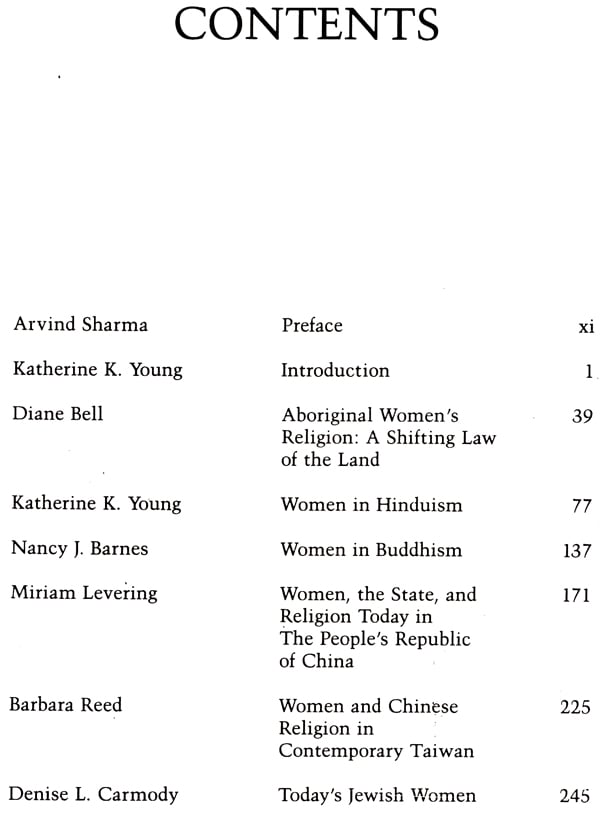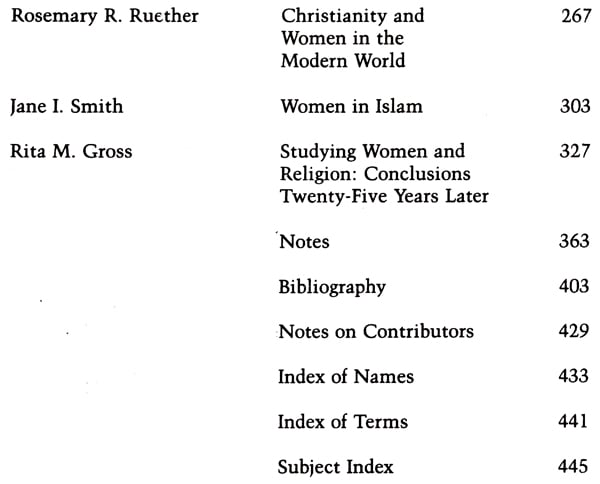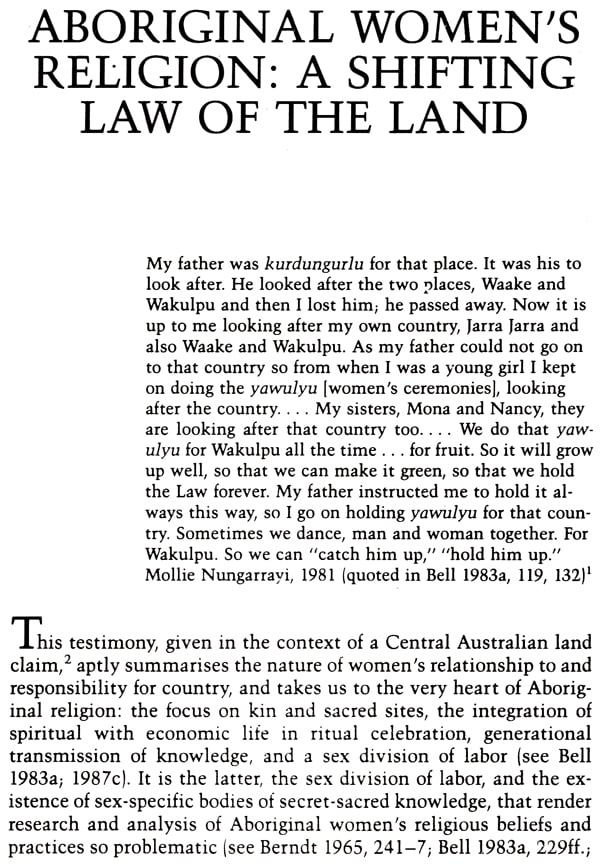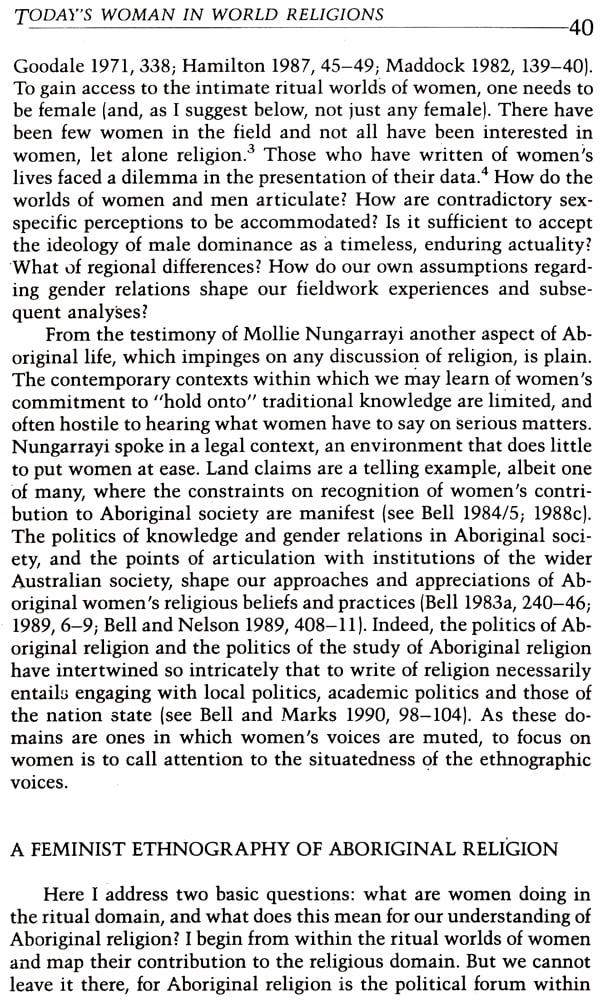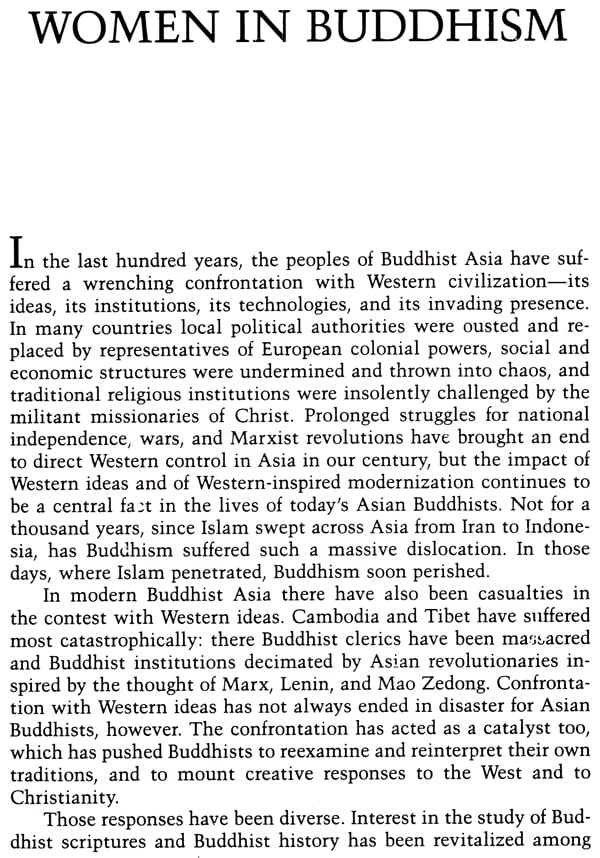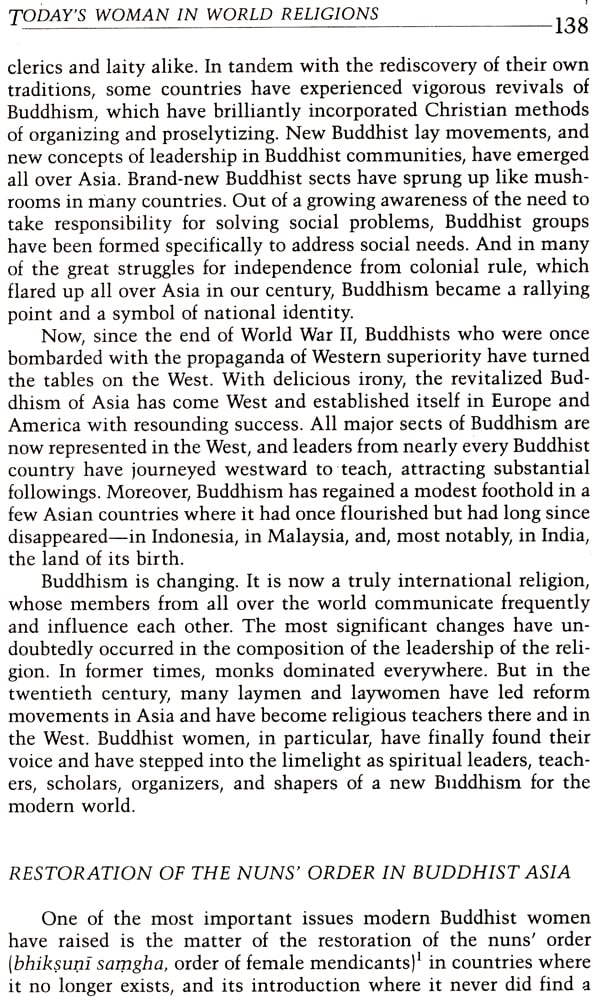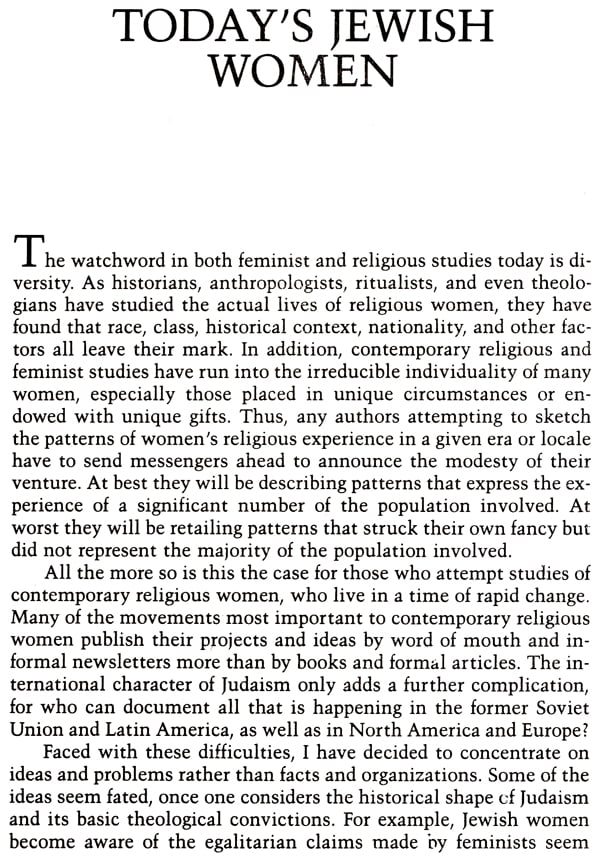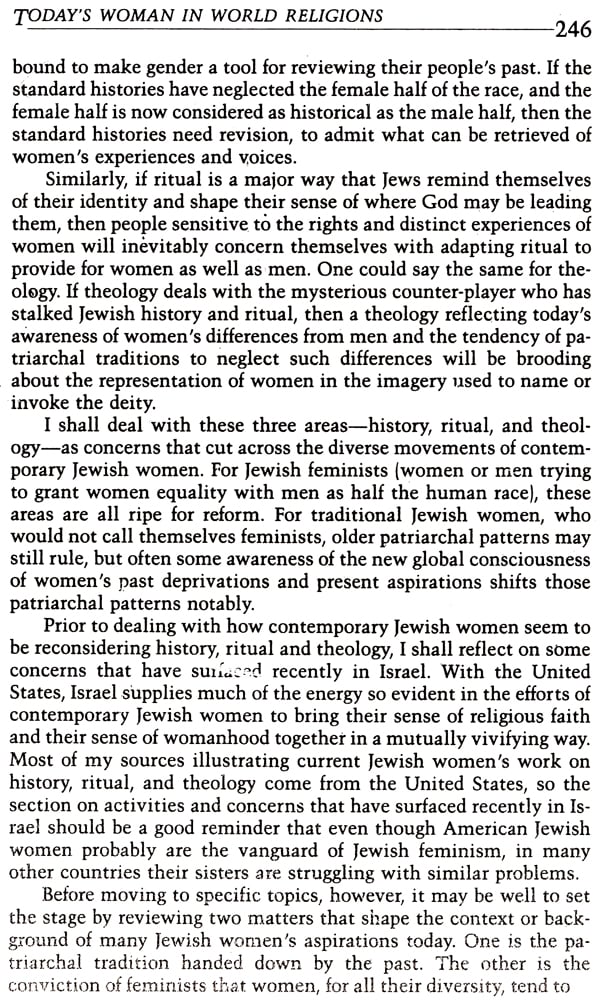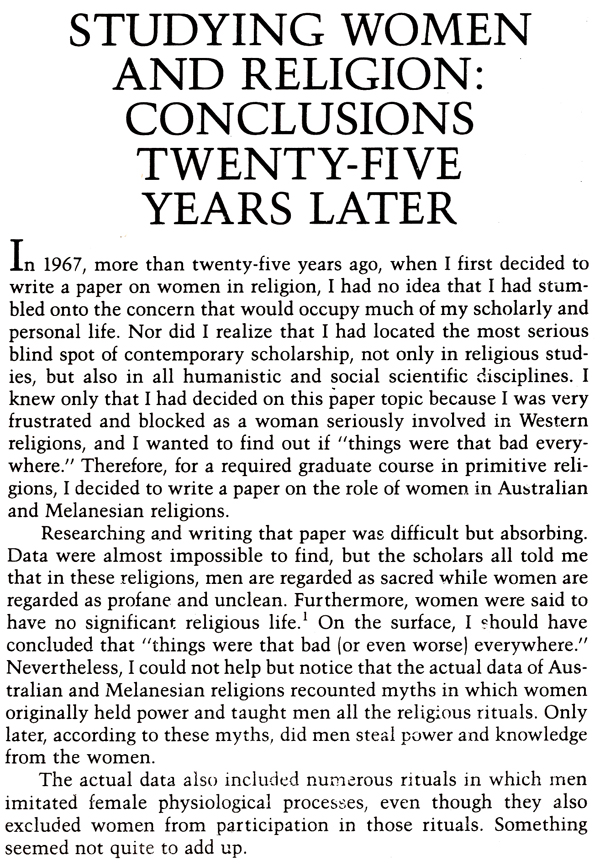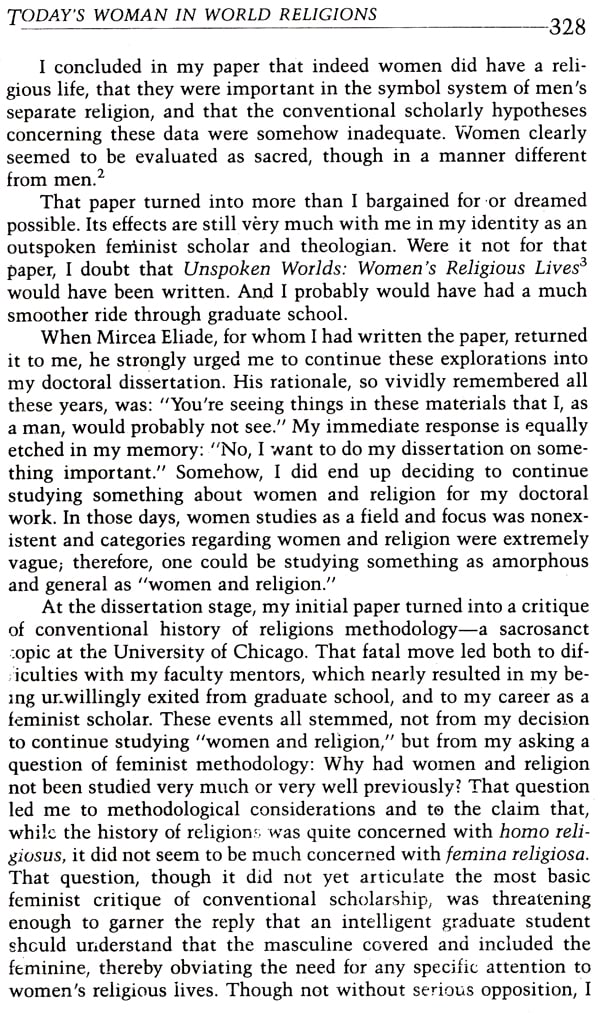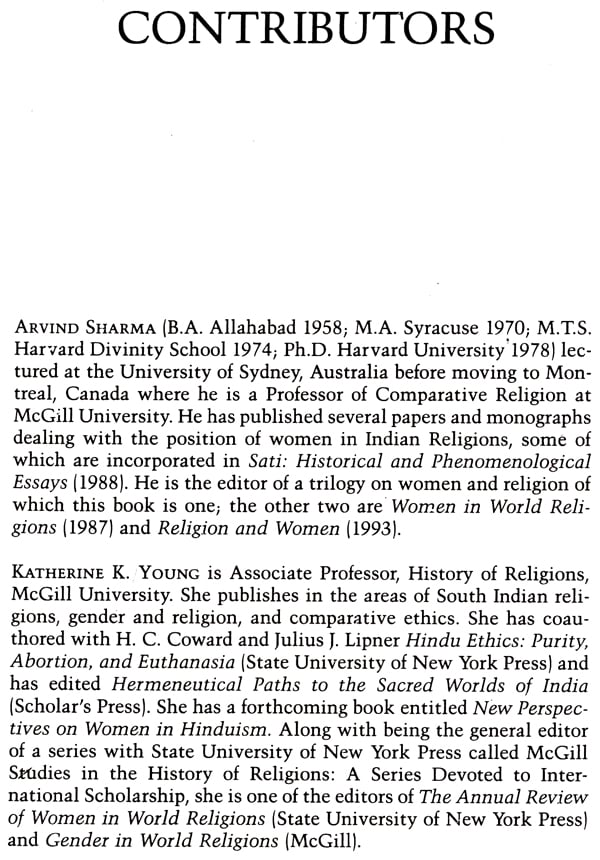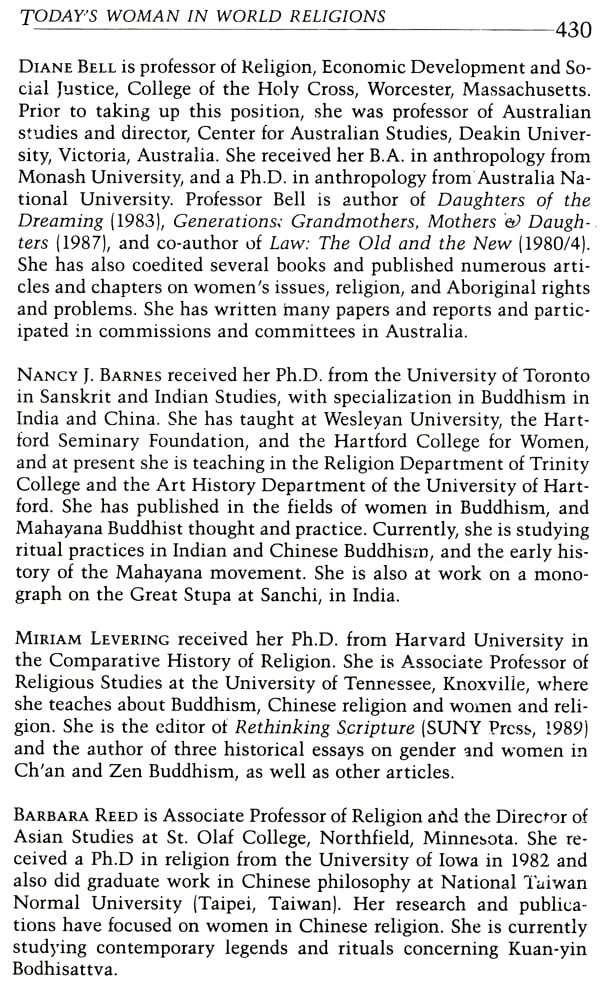
Todays Woman in World Religions
Book Specification
| Item Code: | NAS407 |
| Author: | Arvind Sharma and Katherine K. Young |
| Publisher: | Sri Satguru Publications |
| Language: | English |
| Edition: | 1997 |
| ISBN: | 8170305667 |
| Pages: | 476 |
| Cover: | HARDCOVER |
| Other Details | 9.00 X 6.00 inch |
| Weight | 650 gm |
Book Description
It is impossible to decipher not only the outcome but even the origins of one's actions. Over a decade ago I undertook to put together a book on world religions in which women scholars would write about the position of women in the religions of the world. It was to be a book by women about women for women-and for men. As I proceeded to compile such an unprecedented book, this act of academic temerity may have caused me to falter but for the surprising and spontaneous support the project received from all the scholars I approached regarding it.
The success of that book, Women in World Religions (SUNY Press, 1987), also highlighted its limitations: it did not, even if only because it could not, cover as many religions as one would have liked. And while it offered a historical survey of the position of women in the religions it did cover, it did not tackle the contemporary issues pertaining to women in the various traditions. The treatment of the past, howsoever rich, can never be an adequate substitute for the treatment of the present, howsoever turbulent.
I must thank Bill Eastman for responding with enthusiasm to my suggestion that these shortcomings be rectified by the publication of two companion volumes. Religion and Women would extend horizontally the discussion of the position of women beyond the seven traditions of Hinduism, Buddhism, Confucianism, Taoism, Judaism, Christianity, and Islam to include Native American, African, Shinto, Jaina, Zoroastrian, Sikh, and Baha'i religious traditions as well; and Today's Woman in World Religions would extend the discussion of the seven traditions, initiated in Women in World Religions, vertically into contemporary times afid thus bring it up to date. What began as one book thus ended as three-as a trilogy, a development that should not take most of the readers familiar with the Christian tradition by complete surprise! The publication of this book completes the trilogy.
It is a matter of great personal satisfaction and gratitude for me that virtually the entire team that produced Women in World Religions has participated in the publication of the present volume. Theresa Kelleher had to bow out but Miriam Levering and Diane Bell came aboard. I must also acknowledge here the support I received in putting this book together from Julia D. Howell and Louise Edwards of Griffith University, Faye Sutherland of the University of New South Wales, and Tamara Jacka of the University of Adelaide-all from distant Australia! My indebtedness extends further and lies closer to home as well, for I must also thank Ella Laffey and Laurel Bossen of my own university, Norma Diamond of the University of Michigan, Ann Anagnost of the University of Washington, Emily Honig and Helen Siu of Yale University, Ellen Judd of the University of Manitoba, Margery Wolf of the University of Iowa, Terry Woo of the University of Toronto, and Lee Raynui of Memorial University, Newfoundland, for pointing me in the right direction when I might have gone astray. My sense of thankfulness to them induces the wry self-reflection that those whose friends and colleagues have talent need not fret too much over their own!
It has been said that no project is really finished; it is merely abandoned. And so as I now abandon this project, I hope not prematurely, I am happy to leave the matter in the hands of the reader.
This book is about how the women's movement is affecting traditional religions and civilizations throughout the world. Where it will lead is not yet certain, but one thing is clear. We can no longer understand our world, much less direct its course, without coming to terms with this phenomenon. Understanding the global impact of the women's movement on religion, however, is a daunting task. It has been difficult to recover the history of women in various religions of the world and search for a comparative perspective, and it is even more difficult to understand the flow of history in medias res. Identity, economics, politics, economics, ideology, and scholarship collide. In some countries, the women's movement is being shaped by the first wave of industrialization accompanied by the breakdown of extended families, rural communities, and traditional gender roles. In others it is shaped by the identity crisis that usually follows colonialism. Because the women's movement began in the West, it has been associated with cultural imperialism and secular-ism-anathema to new nations searching for identity in their own religious traditions. In the West itself, the advent of post industrialism is causing profound upheavals in the workplace and basic social institutions leading some to question the meaning of progress.
The contributors to this volume have written extensively on the history or anthropology of women in Hinduism, Buddhism, Taoism, Confucianism, Judaism, Christianity, Islam, and Australian aboriginal religion. And yet some have found that even less research has been done on women and religion today than was done at earlier times. In fact, the primary materials have often never been gathered.
Diane Bell, an anthropologist, says that "if we begin with the ethnography-that is, what women are doing-and build from there to map women's strategies, we are writing a special kind of situated ethnography, one where the participant observation is with women, and one that relies on what can be learned from women of women's business." Bell studies Australian aborigine women's religion. Through her description of the women's domain, she is able to explain anomalies and points of confusion in the interpretations of her male colleagues. Drawing on her extensive field work on Australian aboriginal women and her job as an applied anthropologist-this involved mediation between the women and the Australian government over land-Bell explores upheavals in the religious lives of aboriginal women.
Katherine K. Young reports on interviews with both leaders of the women's movement in India and those worried about current threats to Hinduism. She thus exposes a growing tension in Indian society over the position of women. Nancy J. Barnes utilizes her Buddhist networks to piece together information of the nun's order in some Buddhist countries and on what is being done about reviving it in others. She also tells us about the accomplishments of exemplary Buddhist women today: spiritual leaders, religious teachers, reformers, and academics.
After assessing, whether the position of women has improved in communist China, Miriam Levering looks specifically at women today in Chinese Christianity, Taoism, and Buddhism to see how have they been effected by the Chinese revolution. Barbara Reed analyzes published materials and interviews to understand the current relation between women and religion in Taiwan. Jane Smith examines .a variety of sources to analyze the dialectic of religion and politics in four Islamic countries-Egypt, Saudi Arabia, Iran, and Pakistan.
To do jukice to the global story of women and Christianity, Rosemary RaCIford Ruether reports on a questionnaire she devised and sent to female church leaders in west European, Latin American, North American, Asian, and African countries. Besides basic information on Christianity, she asked about women's church activities, the extent of professional ministry done by non ordained women, whether women are ordained, how many are ordained, how many female students and professors are in theological schools, the teaching of women's studies in those institutions, the networks of women in theology, and the major issues that feminist theologians address. Denise Lardner Carmody examines various Jewish experiments to bring women into sacred learning and religious leadership in both Israel and the United States.
Drawing on her knowledge of three religious traditions (Judaism, Australian aboriginal religion, and Buddhism), Rita M. Gross offers her methodological insights on women and religion. She explores the delicate issue of directing feminist criticism against other religious traditions. Because historians of religions are trained to understand other religious traditions with empathy-which involves bracketing out their own presuppositions in order to approach the religion on its own terms-it has been considered inappropriate to criticize them. Gross argues that it is "more appropriate to criticize one's own cultural-religious situation and the scholarly methods derived from it than the 'other'; when dealing with 'others' we should do the scholarly task of description and leave the judgment to the reader."
Research on women often goes beyond description; a feminist analysis subjects the topic of women and religion to critique. This has been the approach of several of the scholars in this book. Bell draws attention. to the political nature of the study of women and religion in her discussion of the Australian aborigines. She argues that religion and politics (local, national, and academic) are so intertwined that to write of the former means becoming involved with the latter. Although Bell exposes the political dimension of religion and scholarly writing about religion, she does so without becoming ideological. Her interpretations are not politicized in the sense of weapons forged for an ideological battle; rather they serve to illumine the interactions of Australian aboriginal women and men as well as their interaction with male government officials and scholars of both sexes. Through her re-search, Bell recovers women's religious views and practices. Her findings allow her to appreciate the deep egalitarianism of former aboriginal religion and the complementarity of gender roles; these are fast being eroded by cultural assimilation into the frontier society of the Australian outback where men dominate. Because egalitarianism is at the core of the aboriginal worldview, Bell experiences no conflict between the restoration of traditional aboriginal values and her own goals as a woman. In this sense, her task is easier than that of other scholars represented here who find hierarchy and marginalization of women at the core of traditional religions.
THE WOMEN'S MOVEMENT: RELIGION, MODERNITY, AND IMPERIALISM REVISITED
Articulating a widespread view of feminists, Carmody claims that there are two matters that shape the women's movement: one , is patriarchy and the other is the unique needs and contributions of women as a class. By "patriarchy" she means the predominance of men in formulating beliefs and institutions, and the fact that men, when defining the concept of humanity, have made women mere "helpers." Patriarchy, in other words, represents the experiences and desires of men (androcentrism) and legitimates a hierarchy of men over women (sexism). This is viewed as unjust (the underlying assumptions being that women have different experiences and needs, and that subordination is exploitation). She believes, for instance, that "the majority of Jewish women nowadays are aware that patriarchy is neither inevitable nor just." Gross draws attention to much the same thing when she refers to the idea of women naming their own reality and demonstrating that patriarchy is not a biological given. Critiques of patriarchy and hierarchy are closely related to the critique of domestic segregation Of women and the call for women to move into the public spherevmaugh jobs, education, and leadership positions. The women'S movement is pre-eminently one for equal rights, equal status, and freedom to decide life patterns and careers. As Gross says: "The old gender hierarchy proclaimed that men have rights that women do notiund that gender dualism gave men the public &main and taught women to value the private." Critiques of androcentrism, anerarchy, and segregation lead to a critique of the family, since if f s structured and legitimated by patriarchal values. They also lead to a call for the solidarity of all women worldwide, the presupposition being that androcentrism, hierarchy, and segregation are extremely widespread if not universal. Feminist theology for third-world women, according to Ruether, is the "eruption within the eruption of an oppressed and dominated people."
Levering notes that in communist China the male-dominated party tried hard to prevent such an eruption. With its interest in class struggle, it classified women according to the status of their fathers and husbands, oblivious to the fact that even women of the landlord class had never owned property. Although they organized a women's federation to mobilize women, male party leaders did not allow it to represent women's interests. Accordingly, control of the party remained in men's hands. Western feminists argue that in the final analysis critiques must be extended to all forms of hierarchy and segregation, be they defined by race, class, or sex.
**Contents and Sample Pages**
